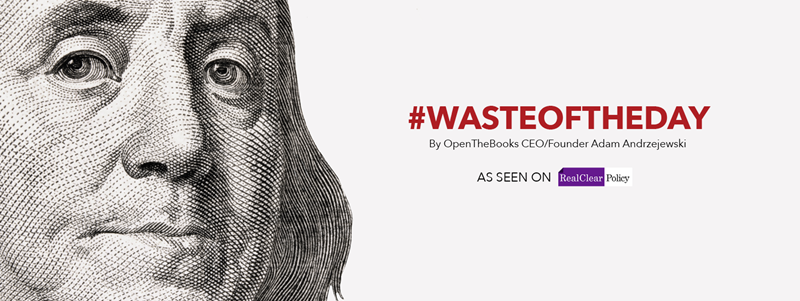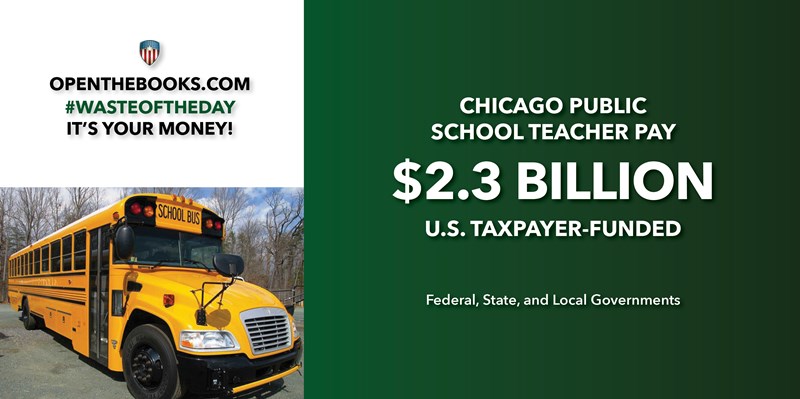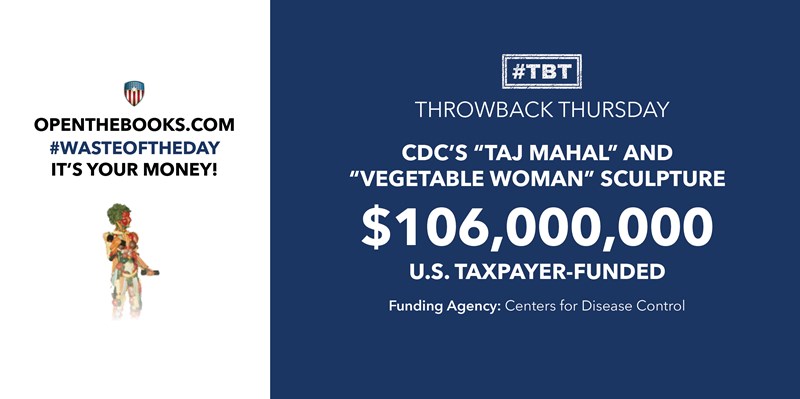
March 1, 2021
$2.3 Billion Paid To Chicago Public School Teachers – Who Refused Classroom Teaching
20,927 full-time teachers in the Chicago Public School (CPS) system may be headed into Chicago classrooms for the first time since March 2020, after approximately 13,000 Chicago Teacher Union (CTU) members voted to go back.
In 2020, Chicago taxpayers spent $2.3 billion on teacher payroll, while 347,476 enrolled CPS school children logged on from home.
That’s an average annual teacher compensation package of $108,729 ($81,422 in salary, $27,307 in benefits), according to records obtained by OpenTheBooks.com through a FOIA request. CPS teachers also can accrue 244 days of sick leave (more than an entire 175-day school year) or apply it to their pensions.

We found Janice K. Jackson, CEO of CPS, made $322,839 – a $260,000 salary and $62,839 in benefits. The 522 Chicago principals averaged $194,000 in pay and benefits, with the highest earners making up to $219,000. Another 304 acting, interim, assistant, and resident principals averaged $171,315 in pay and perks. Even custodians had compensation packages as high as $101,177 in 2020, with 22 earning up to $75,066 in base pay.
Last year Maurice Swinney, CPS’s “Chief Equity Officer,” made $214,000 managing a group of six employees. The pay vastly exceeded the $177,412 salary of Illinois Governor J.B. Pritzker.
While many Chicago parochial and private school students sat in classrooms with full-time teachers, when CPS teachers were asked to report in person on Jan. 4, only 49% did, and some no-shows were locked out of online classrooms. When it was announced, CPS would reopen on Feb. 1, 71% of the CTU voted to defy the order.
Now that they are headed in, CTU president Jesse Sharkey wrote to his membership “No-one [sic] sacrificed more in this struggle than our rank and file members who were locked out, docked pay or faced discipline, and we owe them our most profound thanks for making the impossible possible.”
“No-one”?
March 2, 2021
The $15.5 Million Federal Agency CEO — At the Tennessee Valley Authority
During 2019 and 2020, the new CEO of a federal agency was paid $15.5 million over two years, while outsourcing 120 technology jobs to foreign workers.
In 2004, Congress removed a 71-year-old provision that previously capped the Tennessee Valley Authority (TVA) executives’ pay at the salary of a Member of Congress (then $136,900, today $174,000) and told the TVA to hire competitively.
It just took a few years for the previous salary cap to transform into a multi-million windfall for Jeffrey Lyash, who moved from Canada to Tennessee for the job. His compensation amounted to $8.2 million in 2019 and $7.3 million in 2020.
Unlike Dr. Anthony Fauci, who earned $434,300 last year, TVA employees do not receive taxpayer-funded salaries. 100 percent of the TVA's operating revenues are customer generated.
The TVA is a federally-owned utility and holds a competitive advantage that is funded by American taxpayers. For example, the TVA does not pay state, local or federal taxes and its debt—currently more than $20 billion— counts as debt to the federal government.
lus, taxpayers paid $1.3 billion for the TVA dam and other steam power plants from 1933 to 1959.
In April 2019, the TVA hired Lyash and agreed to pay him $8.2 million. The package included a $445,846 salary; a $380,00 bonus; $480,085 in recruitment/relocation incentives; 401K retirement contributions; and millions in “other” compensation and deferred pension earnings.
Then, in 2020, Lyash got $7.3 million in compensation. The CEO received a $1.1 million salary; a $2.4 million “annual performance incentive;” a retention award incentive of $338,000, and $1.092 million in “other compensation,” including part of his “recruitment/relocation incentive award.”
President Trump was asked about the TVA CEO’s compensation last year and said, “It’s ridiculous. I don’t know the gentleman, but he’s got a heck of a job. He gets paid a lot of money.”
March 3, 2021
286 Interior Designers Employed in Federal Agencies Made $120 Million Since 2017

Who knew? Fifteen federal agencies employed 286 full-time interior designers who made up to $165,417 annually.
In 2019, the latest year available, “interior designers” were paid $24.3 million in cash compensation alone. The cost of healthcare, perks, and pension benefits would add at least 30 percent – an additional $7.5 million per year.
Our auditors at OpenTheBooks.com found that the average salary was $83,185. However, 58 designers made between $100,000 and $165,417.
Since 2016, the number and cost of interior designers in federal agencies grew. In the last year of the Obama administration, there were 270 interior designers employed with payroll costs amounting to $22.1 million. Today, there are 286 employed.
Over the past four years, we estimate $95 million in cash compensation was spent on interior designers within federal agencies. The amount would likely exceed $120 million when adding the cost of benefits.
Veterans Affairs employed the vast majority of interior designers: 189 for $14.3 million in cash compensation. The VA also paid out the largest bonus for an interior designer across all agencies -- $5,500 was awarded to a VA interior designer in the San Diego, California area.
In 2016, the VA employed 171 interior designers, so the agency has continued padding its interior designing payroll in the years since.
This isn’t the first time that we’ve exposed the VA’s taste in decorating and artwork. In 2016, our auditors at OpenTheBooks.com quantified $20 million spent on high-end, luxury artwork coded as “furniture” inside the VA checkbook.
Some of the other federal agencies and the number of interior designers employed:
General Services Administration (37), State Department (23), Transportation (5), Commerce (4), Social Security Administration (3), Energy (3), and Treasury Department (3).
March 4, 2021
$106 Million “Taj Mahal” Visitor Center & “Vegetable Woman” Sculpture

Throwback Thursday!
In 2007, the Centers for Disease Control and Prevention (CDC) spent $106 million on a new 202,000 square foot global communications center in Atlanta, Georgia.
The new structure included a conference center, visitor’s center, information center, and a media services facility. It was named after U.S. Senator Tom Harkin (D-IA), who was the ranking member on the appropriations committee (which funded the CDC).
U.S. Senator Tom Coburn (R-OK) released an oversight report “CDC Off Center” that showcased the wasteful spending. The Wall Street Journal called the facility the CDC’s “Taj Mahal.”
The CDC spared no expense, including a sculpture of a “woman” made from vegetables.
In honor of Women’s History Month, the exhibit was displayed from January through April 2007. It was created “with funding from the Centers for Disease Control and Prevention (CDC), National Institutes of Health (NIH), MetLife Foundation, and Pfizer Women’s Health.”
The CDC also featured a “digital ballet” on its newly installed, giant wall of plasma screen TVs.
According to Archi Tech Magazine, the CDC’s Global Symphony program was “a complex digital ballet of hundreds of video elements that play randomly … The payoff was a unique information environment that makes what many consider to be an intimidating place at a time of global pandemic warnings a lot more welcoming.”
Here’s how the architect described the CDC’s four-story Tom Harkin Global Communications Center:
“provides state-of-the-art meeting space, a hub for distance learning, and a place for visitors to study and learn about public health... The complex includes a conference facility and information center that provides learner-centered auditoria and classrooms equipped with technology for multimedia communications; production studios with satellite broadcast, interactive video and Internet webcast capabilities; a secure communications and control center; and a joint Emory University/CDC program office.”
It also includes a learning resource center and public health library, as well as a 1,100-vehicle parking deck.
Unfortunately, the CDC did not spend taxpayer money on something a lot more useful during an actual pandemic – i.e., test development.
March 5, 2021
Veterans Affairs Purchased $25.5 Million In Guns, Ammunition and Military-Style Equipment

Since 2010, Veterans Affairs (VA) spent $25.5 million on guns, 11 million rounds of ammunition, and other military-style equipment such as camouflage uniforms, riot helmets and shields, specialized image enhancement devices, and tactical lighting.
Our auditors at OpenTheBooks.com quantified the spending using data released subject to the “Federal Funding Accountability and Transparency Act of 2006” and Freedom of Information Act requests.
In 1996, the VA did not employ a police force.
Today, however, the VA has 4,547 law enforcement officers armed with weapons including semi-automatic “long-guns” (i.e., AR-15-style). The number of officers is up by nearly 700 just since 2016.
Yet, since 2016, the VA has refused to respond to our request to disclose their crime statistics.
However, in September 2020, the non-partisan, congressional watchdog agency, the Government Accountability Office (GAO) studied the VA’s “use of force” database.
The GAO found that the use of force was rare. When documented by the VA, however, the reporting was incomplete, inaccurate, duplicative, and not broken out by medical center.
The #WasteOfTheDay is presented by the forensic auditors at OpenTheBooks.com.